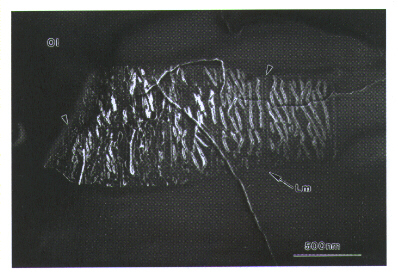

Current thermo-kinetic models of the transformation of olivine to its high
pressure polymorphs wadsleyite and ringwoodite in subducting lithosphere
are based on the single transformation mechanism of incoherent nucleation
on grain boundaries and interface-controlled growth. Although a second,
intracrystalline transformation mechanism for the high pressure transformation
of olivine is also known, detailed investigations of the nature of this
mechanism and its importance in subduction zones have not yet been conducted.
Therefore, as part of a systematic investigation of the high pressure transformations
of olivine (see Annual Reports 1995 and 1996), we have extensively studied
the nature of the intracrystalline olivine->ringwoodite transformation.
Using optical and transmission electron microscopy (TEM) partially-transformed
olivine samples from a series of quasi-hydrostatic multi-anvil experiments
at pressure-temperature conditions nominally in the ringwoodite stability
field have been investigated. Three types of transformation morphologies
have been observed in these samples. (1) All olivine grains undergo transformation
by incoherent grain boundary nucleation and growth, which leads to the
formation of reaction rims around the olivine grains. (2) Intracrystalline
transformation has been observed, but only in large olivine crystals (~
600 µm). This mechanism proceeds by the coherent nucleation of thin
ringwoodite lamellae on (100)ol stacking faults and the thermally-activated
growth of the lamellae in length and thickness by the lateral migration
of interface ledges. Viewed edge-on (along [010]ol or [001]ol),
the interface ledges are steps a few unit cells in height. Weak beam TEM
investigations of the flat faces of the lamellae parallel to (100)ol
and {111}rw, reveal that the ends of the ledges are complex
regions of lattice misfit and are oriented normal to [001]ol,
[013]ol or ![]() ol
(Fig. 3.1-1). This preferred orientation of the ledges indicates that their
migration is fastest in the [001]ol, [013]ol and
ol
(Fig. 3.1-1). This preferred orientation of the ledges indicates that their
migration is fastest in the [001]ol, [013]ol and ![]() ol
directions and also explains why the flat sides of larger lamellae are
normally not circular in shape but rather are elongated in the [001]ol
direction (Fig. 3.1-1). The rates of lamella thickening as determined from
an evaluation of a series of weak beam images are several orders of magnitude
slower than growth rates of incoherent, grain boundary nucleated grains,
although the activation energies for both processes are similar (~ 260
kJ/mol). The high activation energy is likely to be a consequence of the
breaking of Si- O bonds at the interfaces being the rate-controlling
ol
directions and also explains why the flat sides of larger lamellae are
normally not circular in shape but rather are elongated in the [001]ol
direction (Fig. 3.1-1). The rates of lamella thickening as determined from
an evaluation of a series of weak beam images are several orders of magnitude
slower than growth rates of incoherent, grain boundary nucleated grains,
although the activation energies for both processes are similar (~ 260
kJ/mol). The high activation energy is likely to be a consequence of the
breaking of Si- O bonds at the interfaces being the rate-controlling
 |
Fig. 3.1-1: Weak beam TEM image ( g = [004]ol) showing the flat face of a ringwoodite lamella (Lm) parallel to (100)ol and {111}rw, which is elongated in [001]ol. In the surrounding olivine (Ol) a dislocation is visible. The thick, light, slightly-bent lines in the interior of the lamellae are the ledges at the lamella interface. Thin straight lines (arrow heads) are intersections of internal {110}rw stacking faults with the interface. |
process. (3) The interfaces of the lamellae serve as nucleation sites for further, incoherentringwoodite and/or wadsleyite grains, which grow much faster than the lamellae themselves and form polycrystalline lenses in the olivine crystals, which are aligned approximately parallel to {101}ol.
The results of this study suggest that intracrystalline transformation is likely to occur in subducting lithosphere where coarse-grained olivine and moderate differential stresses are expected. Although the lamellae grow much slower than incoherent, grain boundary nucleated grains, intracrystalline olivine->ringwoodite transformation can affect the overall transformation rates because it drastically increases the number of nucleation sites for incoherent ringwoodite and/or wadsleyite grains, which grow relatively rapidly. The occurrence and effects of intracrystalline transformation therefore need to be incorporated in thermo-kinetic models of the olivine->ringwoodite transformation in subducting lithosphere.

Tel: +49-(0) 921 55 3700 / 3766, Fax: +49-(0) 921 55 3769, E-mail: bayerisches.geoinstitut(at)uni-bayreuth.de
 Previous page
Previous page